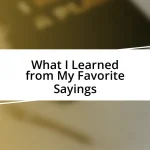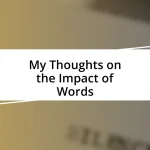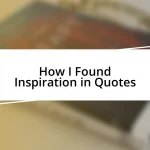Key takeaways:
- Inspiring quotes can arise from personal experiences and resonate deeply with emotions, often prompting reflections on life choices.
- Choosing the right platform for sharing quotes enhances engagement, with options like social media for quick interaction and blogs for deeper reflection.
- Visual elements such as typography, color schemes, and imagery play a crucial role in amplifying the impact of quotes, creating emotional connections.
- Fostering community interaction through thoughtful questions and personal storytelling helps build a sense of belonging and encourages open dialogue among followers.
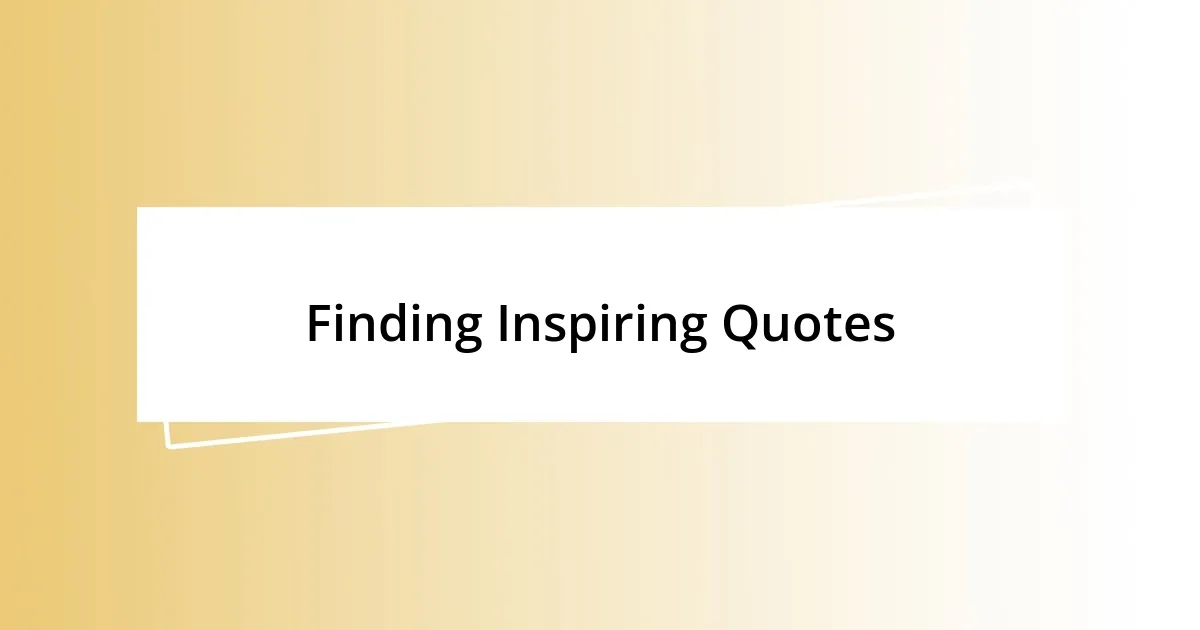
Finding Inspiring Quotes
When searching for inspiring quotes, I often find myself reflecting on moments that impacted me the most. Whether it was a heartfelt conversation with a friend or an emotional scene in a movie, these experiences can lead me to powerful words that encapsulate those feelings. Has there ever been a phrase you heard that just clicked in your mind and made you see the world differently?
One of my go-to places for quotes is literature; there’s something magical about the right sentence emerging from a book. I remember sitting on my cozy couch, immersed in a novel, when I stumbled upon a line that resonated deeply with me. Instantly, it felt like a light bulb went off, nudging me to reconsider my path and choices. Isn’t it amazing how a few thoughtfully chosen words can ignite a spark within us?
Sometimes, I turn to social media or inspirational websites, where I can discover quotes that are fresh and contemporary. While scrolling through my feed, I often come across gems shared by influencers or friends. It’s a wonderful reminder of how we can uplift one another with just a few words—have you ever shared a quote that uplifted someone else’s day? Knowing that these shared sentiments ripple out can be incredibly rewarding.

Choosing the Right Platform
Choosing the right platform can truly amplify the impact of the quotes I want to share. I’ve discovered that each platform offers a unique audience and format. For instance, I once shared a poignant quote on Instagram, pairing it with a striking image. The engagement was incredible, and I felt a rush of joy as people commented on how it resonated with them.
Here are some platforms I consider for sharing inspiring quotes:
- Social Media (Facebook, Instagram, Twitter): Great for visual appeal and quick engagement. I often find interactions more spontaneous here.
- Blogs or Personal Websites: Perfect for longer reflections where I can dive deeper into the meaning behind the quote.
- Pinterest: Ideal for visually appealing quotes, allowing them to spread organically among users seeking inspiration.
- Email Newsletters: A more direct approach; I love crafting personalized messages that include quotes, making my subscribers feel special.
Choosing wisely ensures that the quotes reach those who need them most, and it’s fulfilling to see how different formats resonate with various audiences.

Creating Engaging Visuals
Creating visuals that captivate and inspire is essential in sharing quotes effectively. I’ve found that a mix of bold typography and relevant imagery can speak volumes. For instance, I remember designing a quote graphic featuring a sunset background, which perfectly complemented the message I wanted to convey. The comment section lit up with praise, and many mentioned how the image itself made the words more powerful—have you ever noticed how visuals can create an emotional connection that words alone sometimes can’t?
The colors and fonts I choose play a significant role in conveying the mood of the quote. A soft pastel palette feels calming and encouraging, while vibrant colors can evoke excitement and passion. One time, I used an energetic orange against a clean white background for a motivational quote, and the response was overwhelming. People seemed to feel the energy radiating from the image! It’s fascinating how the right visual elements can enrich the overall message and increase engagement.
When I’m eager to share my favorite quotes, I often utilize design tools like Canva. This platform offers an easy way to create striking visuals without requiring advanced design skills. I can adjust the layout and elements to reflect my style, making it personal. After sharing one such custom graphic on my social media, I received messages from friends who said they printed it out and hung it on their walls. That connection—knowing my visuals could inspire others in their daily lives—gives me such joy.
| Visual Element | Impact |
|---|---|
| Typography | Sets the tone and enhances readability |
| Color Scheme | Evokes emotion and captures attention |
| Imagery | Creates a connection and adds context |
| Layout | Affects focus and flow of the message |
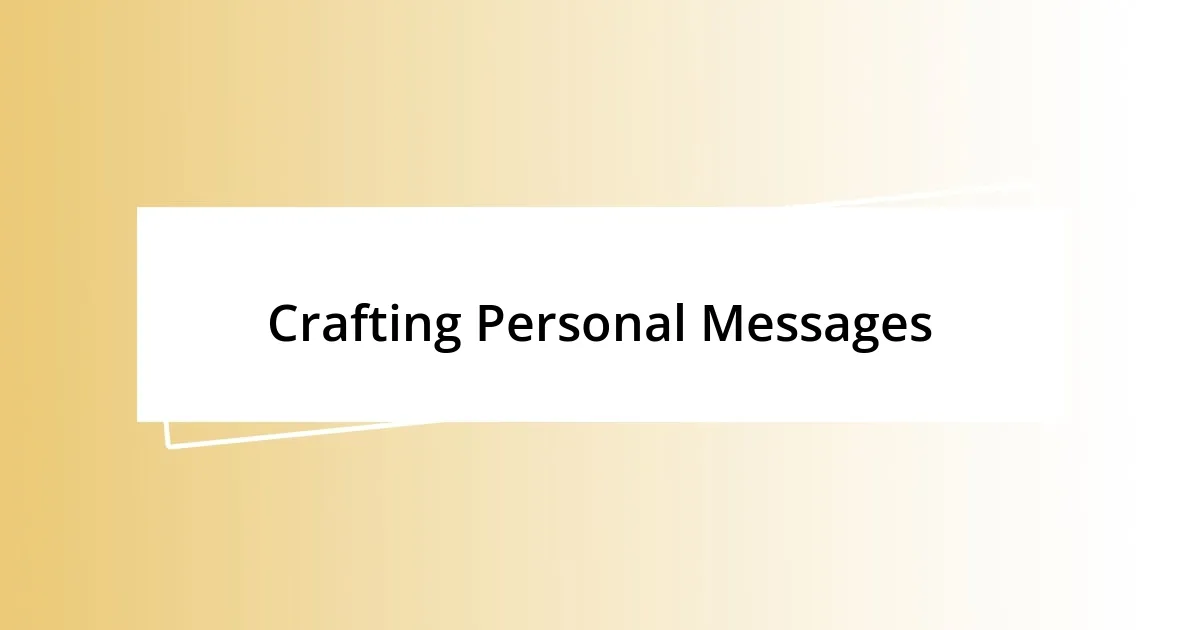
Crafting Personal Messages
Crafting personal messages when sharing quotes is where I truly feel my voice shines. I have this habit of adding a little backstory or context around the quote I share. For example, when I posted a quote about resilience after overcoming a challenging situation, I received messages from friends who expressed how my honesty encouraged them to confront their own struggles. Isn’t it remarkable how a few heartfelt words can forge a deeper connection?
I also love to appeal to my audience’s emotions. When I find a quote that resonates deeply with me, I often ask myself how it can relate to others’ experiences. One time, I shared a quote about kindness right after a random act of kindness transformed my day. In the post, I encouraged my followers to pay that kindness forward. It’s fulfilling to see how sharing a moment from my life invites a similar appreciation from others. Have you ever thought about how your unique experiences could inspire someone else?
Lastly, I think about the tone I want to convey. Depending on the quote, my message might be uplifting, thought-provoking, or even humorous. For instance, after sharing a light-hearted quote about failure, I added my own funny mishap in the kitchen. The laughter and stories that followed from my friends were a testament to how personal touches can turn a simple quote into a shared experience. It’s moments like these that remind me why crafting personal messages is so essential.
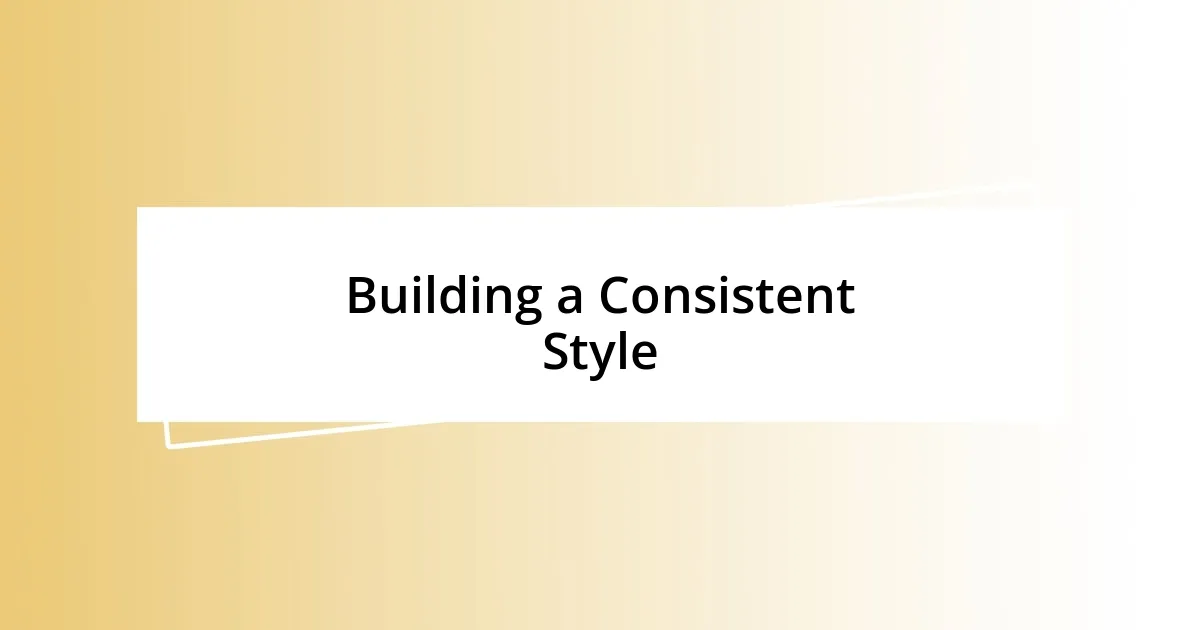
Building a Consistent Style
Building a consistent style is vital when sharing quotes, as it helps create a recognizable brand and fosters connection with the audience. I remember when I first started, I was all over the place with colors and fonts; nothing felt cohesive. Eventually, I settled on a warm color palette paired with a specific font that felt authentic to me. This consistency made my posts feel like pieces of art—do you ever find yourself craving that sense of familiarity in the content you see online?
I’ve also discovered that blank space is an unsung hero in my designs. Restraint can be powerful; by allowing quotes to breathe, I invite viewers to take a moment to appreciate the words. I recall a post that featured a simple quote about gratitude—the empty space around it not only highlighted the text but also allowed the message to resonate deeply. When was the last time you paused to really absorb a quote because it was presented so thoughtfully?
Moreover, consistency isn’t solely about visuals but extends to tone and voice. When I write captions, I aim for a friendly, conversational style, much like a chat with a close friend. I once shared a quote about perseverance, and instead of just posting it, I shared my struggle with maintaining motivation during a tough work project. That combination brought the quote to life, and my followers responded with their own stories, creating a cozy space for shared experiences. Have you thought about how your unique voice could make the quotes you love even more relatable?
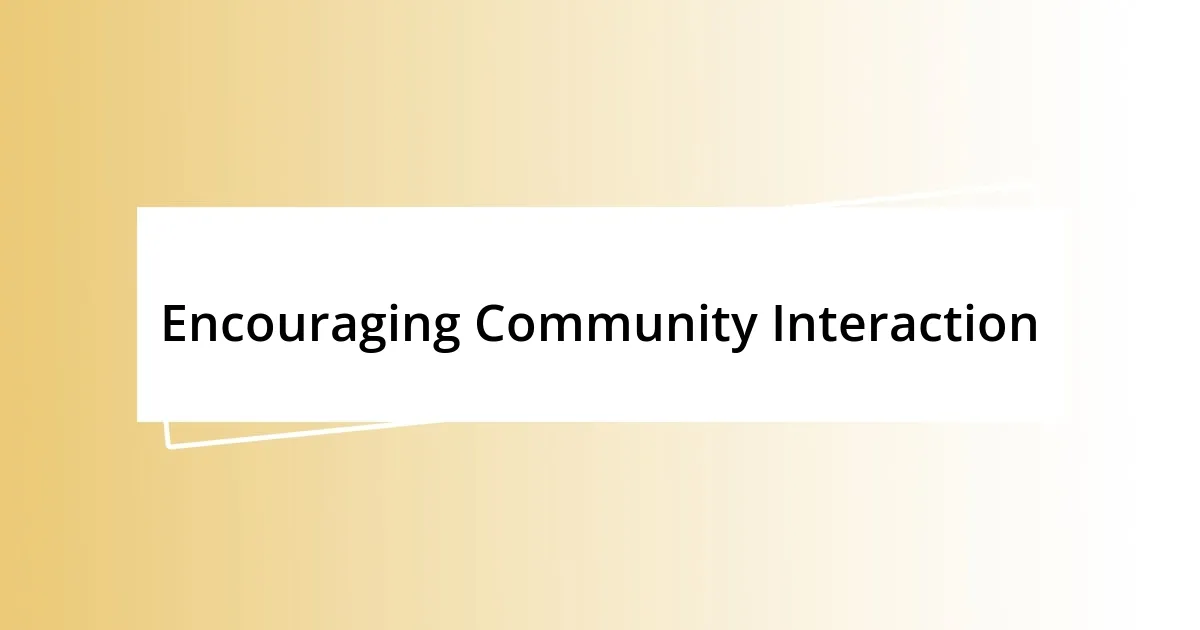
Encouraging Community Interaction
Encouraging community interaction is all about fostering a sense of belonging. I recall a time when I posted a quote about courage, urging my followers to share their own moments of bravery. The flood of responses was heartwarming; people opened up about their challenges in ways I never expected. It felt like we were weaving a tapestry of shared experiences, and each story added a new thread to our collective narrative.
Have you ever considered how powerful it is to create a space where others feel comfortable sharing? I once organized a small gathering around a quote about vulnerability and invited friends to express what it meant to them. What started as a casual exchange quickly transformed into a deep conversation filled with laughter, tears, and revelations. Moments like these remind me that when we encourage others to chime in, we’re not just sharing quotes—we’re building a community.
Furthermore, I find that posing thoughtful questions can ignite engagement. After sharing a quote about change, I asked my audience to reflect on what change meant in their lives. The responses surprised me; I heard stories of personal growth, losses turned into lessons, and dreams that sparked hope. Witnessing this outpouring of emotion was exhilarating. It’s those moments of connection that solidify my belief in the impact of encouraging community interaction.

Measuring Impact and Engagement
Measuring the impact of the quotes I share often feels like a personal journey rather than just a metric analysis. For instance, I remember the exhilaration I felt after a quote about resilience went viral on my feed. The number of likes and shares was great, but the messages I received from people saying how it helped them through tough times truly showcased the quote’s real impact. Have you ever experienced that rush when you know your words are making a difference?
Engagement, for me, is not only about numbers but also about the depth of conversations that arise from each post. One time, I shared a quote that resonated deeply with me regarding self-acceptance. The follow-up discussion was rich with vulnerability, as my audience opened up about their own struggles with self-esteem. I found it fascinating how one quote could kindle such a heartfelt exchange—doesn’t it make you re-evaluate the potential of just a few words?
I actively track engagement by analyzing both qualitative and quantitative data. For instance, I often ask myself how many people are leaving comments versus just liking a post. When my followers started sharing their interpretations of a quote I posted, it sparked a wave of creativity that I hadn’t anticipated. It’s in those moments of shared insights that I gauge true community engagement—doesn’t it feel like magic when words inspire a collective reflection?







